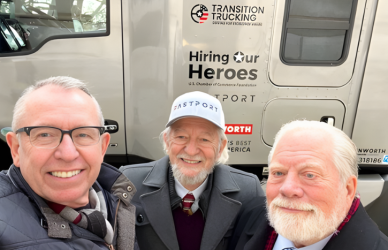The trucking sector is grappling with severe driver retention issues, as emphasized by the Owner-Operator Independent Drivers Association (OOIDA) during a recent conference held in Kansas City, Missouri. This event, arranged by the Mid-America Freight Coalition, assembled a variety of participants, including officials from state Departments of Transportation, engineers, and scholars, to exchange insights about progress in freight logistics. A featured panel dedicated to workforce enhancement highlighted critical topics such as training programs and driver pay.
Lewie Pugh, OOIDA’s Executive Vice President, underscored the notion that driver retention stands as the industry’s core dilemma rather than a lack of available drivers. “Driver retention is a huge problem… There’s not a shortage; there’s never been a shortage of [truck drivers]. The shortage is people staying in this industry. They come in, they get used, they get abused, they don’t get paid right, they don’t get treated right and they leave,” he shared with the audience.
Elevating Training Standards for New Drivers
A significant aspect of workforce improvement lies in the effectiveness of driver training. Despite continued advocacy by OOIDA and other organizations, the entry-level driver training rule that came into effect in February 2022 has still left many new drivers ill-equipped. Pugh has criticized the lack of a compulsory behind-the-wheel training component, citing the rise of CDL schools that promise quick licensure, sometimes within a mere 24 hours. “We need more comprehensive driver training in this country,” Pugh asserted, pointing out the disparity between advancements in truck technologies and the training offered to new drivers.
While cutting-edge safety features like automatic emergency braking and speed limiters are being rolled out, insufficient training can lead to critical mistakes by drivers. Pugh likened the situation to the airline sector, where pilots are required to undergo extensive training prior to implementing new safety measures.
Concerns Over Driver Compensation
Simply improving training won’t suffice to keep drivers if compensation does not reflect their contributions. Pugh brought attention to unpaid detention times, which see drivers spending upwards of 14 hours each week waiting for loading or unloading—without receiving fair pay. Moreover, interstate truck drivers often find themselves excluded from overtime compensation, despite working exhausting 70-hour weeks. Pugh’s analysis indicates that the average truck driver’s annual salary of $55,000 translates to approximately $15.38 per hour.
Legislative movements like the GOT Truckers Act are designed to terminate truckers’ overtime pay exemption, while ongoing transparency issues within the brokerage community continue to hinder fair wages. Upcoming regulations are expected to confront these challenges, responding to concerns raised by an OOIDA petition.
Addressing Systemic Challenges
Many high turnover rates stem from factors beyond compensation, including inadequate parking options, unsatisfactory working conditions, and untested technology. A shortage of secure parking forces drivers into lengthy searches for suitable spaces or drives them to riskier parking choices. The proposed Truck Parking Safety Improvement Act aims to allocate $755 million for enhancing parking facilities. “Truckers don’t need electric signs… they need ground, they need pavement, they need places to park trucks,” Pugh noted.
Access to basic amenities, such as restrooms during deliveries, remains another significant issue. The proposed Trucker Bathroom Access Act advocates for guaranteed restroom access. Furthermore, Pugh raised alarms about the swift introduction of new, unproven technologies, including autonomous vehicles and speed limiters, which could jeopardize driver safety.
For further insights on these pressing matters and to engage with policymakers regarding trucking issues, visit FightingForTruckers.com.
Source: Land Line











